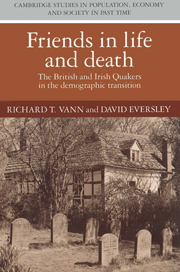Book contents
- Frontmatter
- Contents
- List of figures
- List of tables
- Preface
- Introduction
- 1 The quality of the sources
- 2 Characteristics of the sample
- 3 Marriage according to Truth
- 4 The fruitfulness of the faithful
- 5 The quality and quantity of life
- Conclusion
- Bibliography
- Index
- Cambridge Studies in Population, Economy and Society in Past Time
5 - The quality and quantity of life
Published online by Cambridge University Press: 23 September 2009
- Frontmatter
- Contents
- List of figures
- List of tables
- Preface
- Introduction
- 1 The quality of the sources
- 2 Characteristics of the sample
- 3 Marriage according to Truth
- 4 The fruitfulness of the faithful
- 5 The quality and quantity of life
- Conclusion
- Bibliography
- Index
- Cambridge Studies in Population, Economy and Society in Past Time
Summary
The measurements of births and marriages which we have presented assume their full significance only when we know what toll death was taking. The same level of fertility will obviously have very different consequences if only half the children survive to adulthood than if three-quarters of them do so. Furthermore, it is often easier to detect the impact of conditions like poor nutrition in higher mortality than in lower fertility. This has made mortality rates, especially those of infants and children, the best indicator of standards of living in general: quality and quantity of life come close together.
As with fertility and nuptiality, deaths can either be considered aggregatively, in terms of the numbers occurring in any given period, or by age-specific rates. Since the latter measurements, especially life expectancy, are more discriminating, these are the ones on which we shall concentrate; but some useful information can come from looking at what appear to be “crisis” years in British and Irish Quaker mortality.
A “crisis” of mortality can be variously defined, but in our usage it refers to a season when mortality in a given quarter of a year was more than one and a half times greater than the nine-year moving average for that quarter. We must caution, however, against misconstruing our series of total deaths. Only persons who the registers show had already formed families, and the members of those families, will appear in our mortality figures.
- Type
- Chapter
- Information
- Friends in Life and DeathBritish and Irish Quakers in the Demographic Transition, pp. 186 - 238Publisher: Cambridge University PressPrint publication year: 1992

